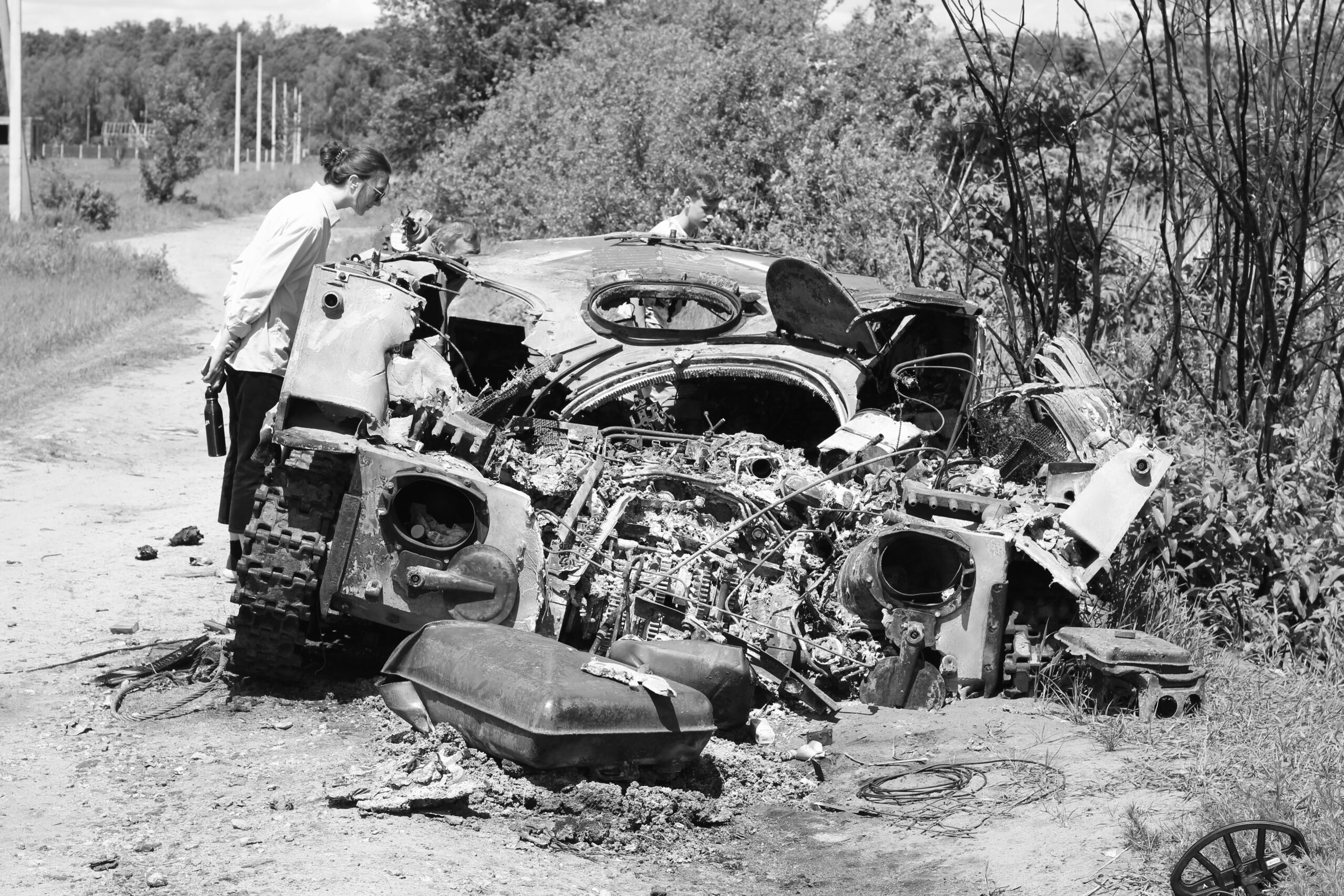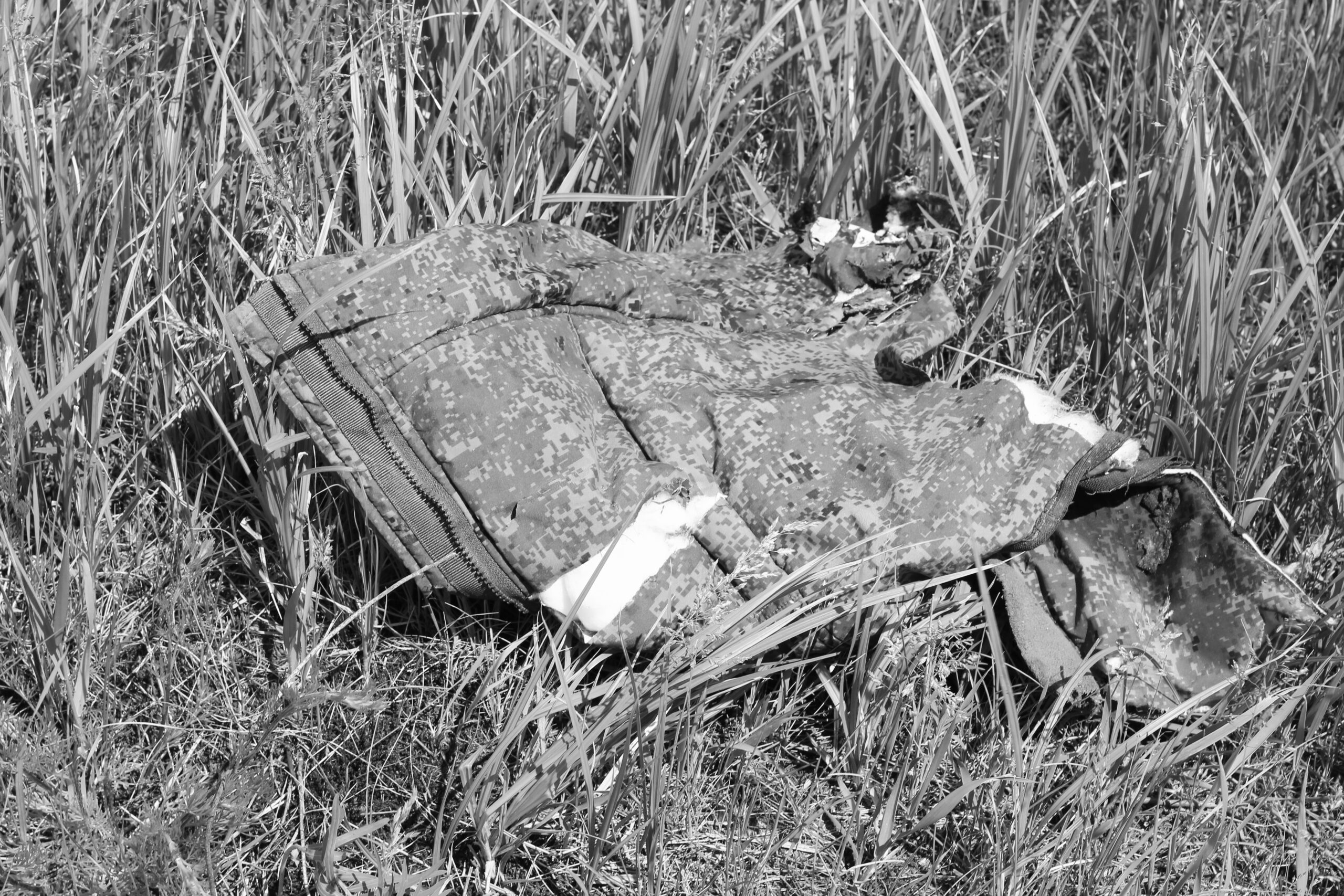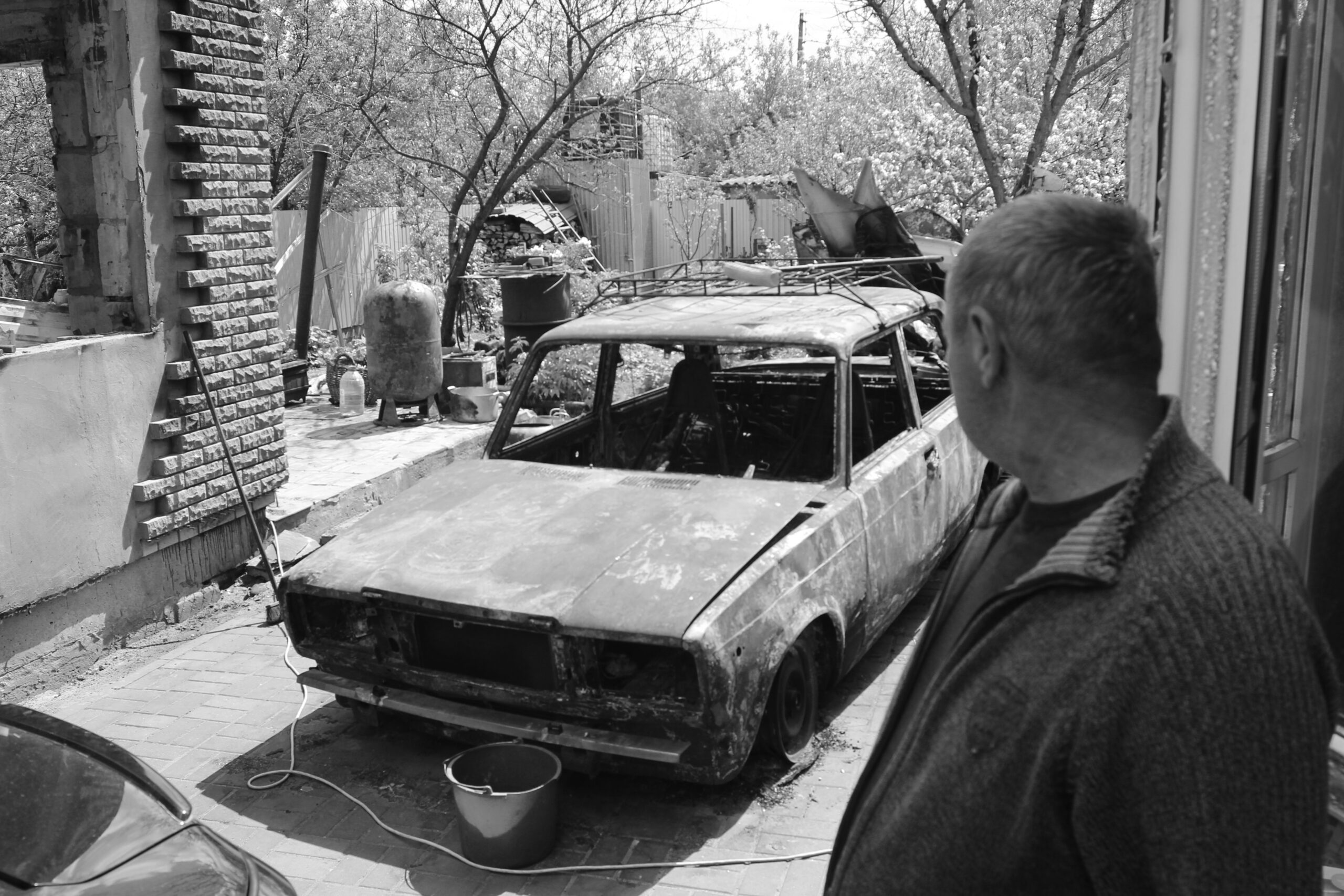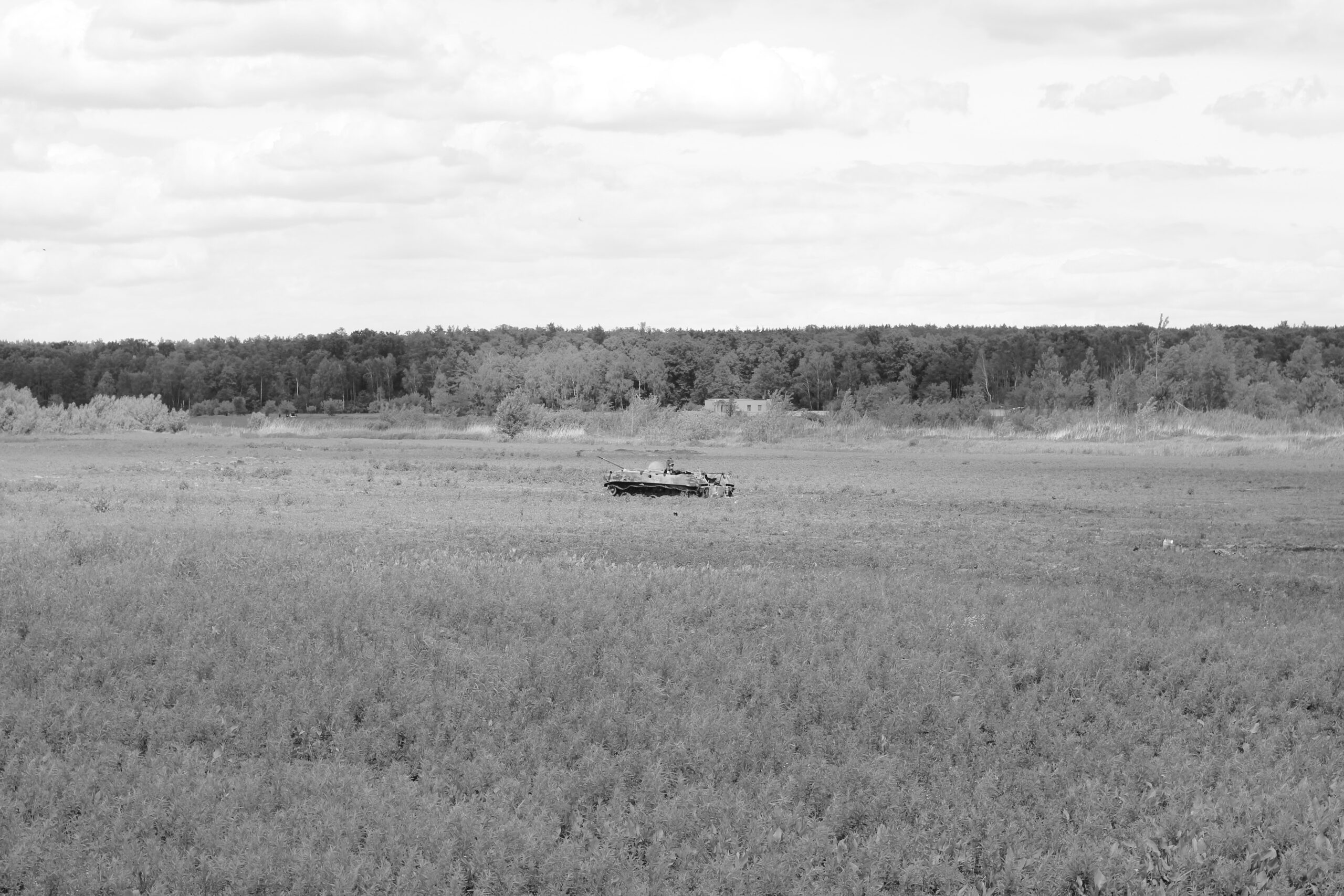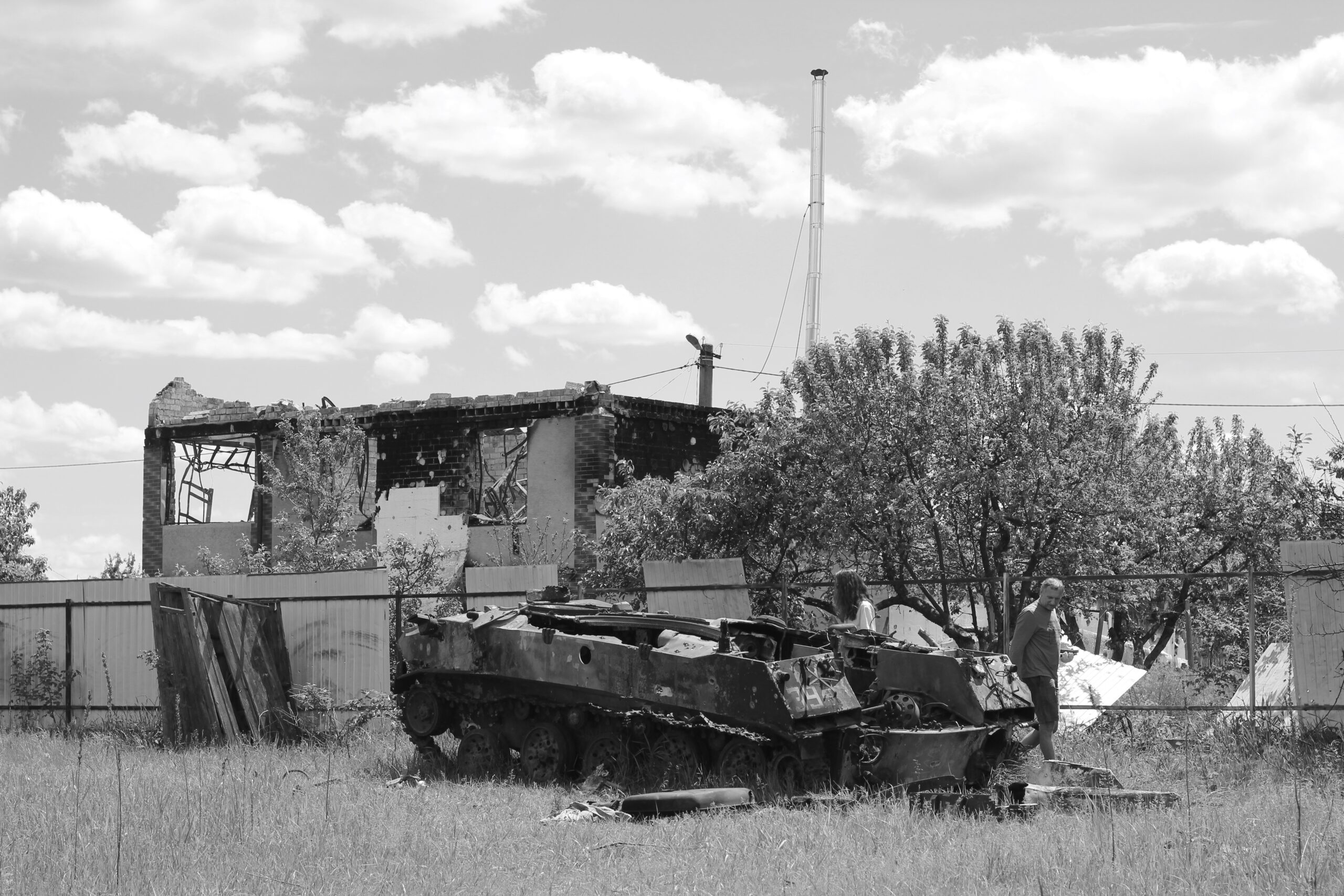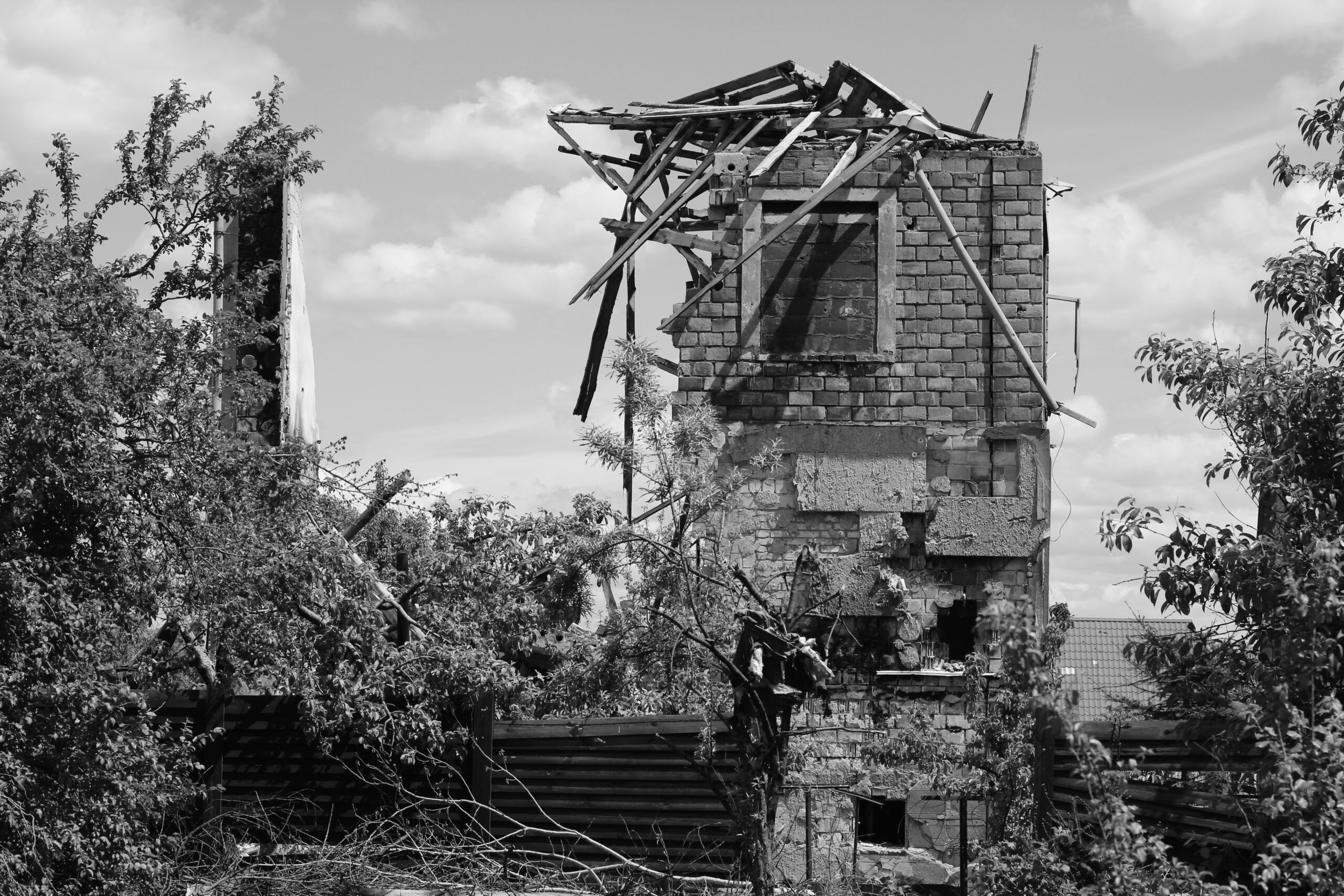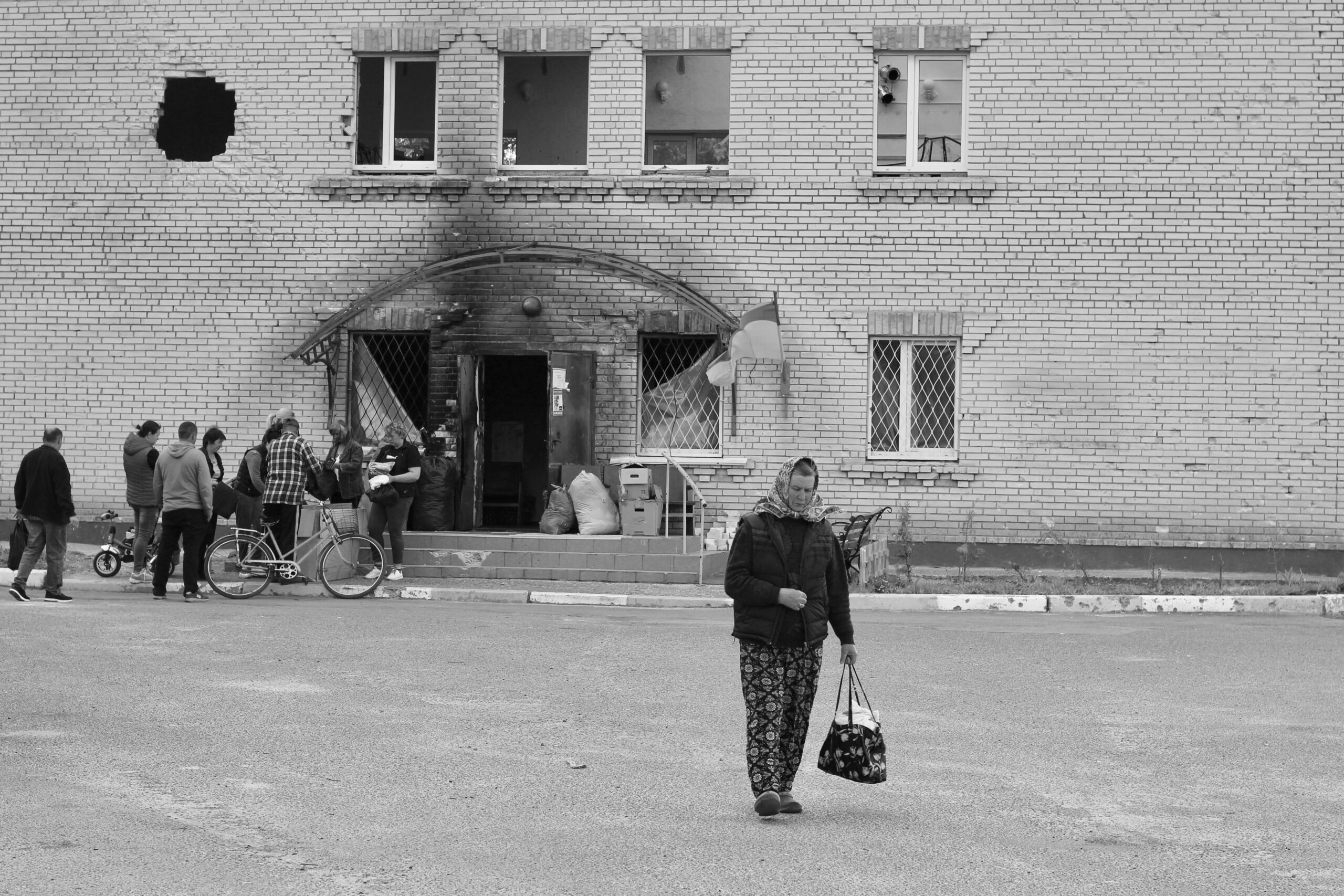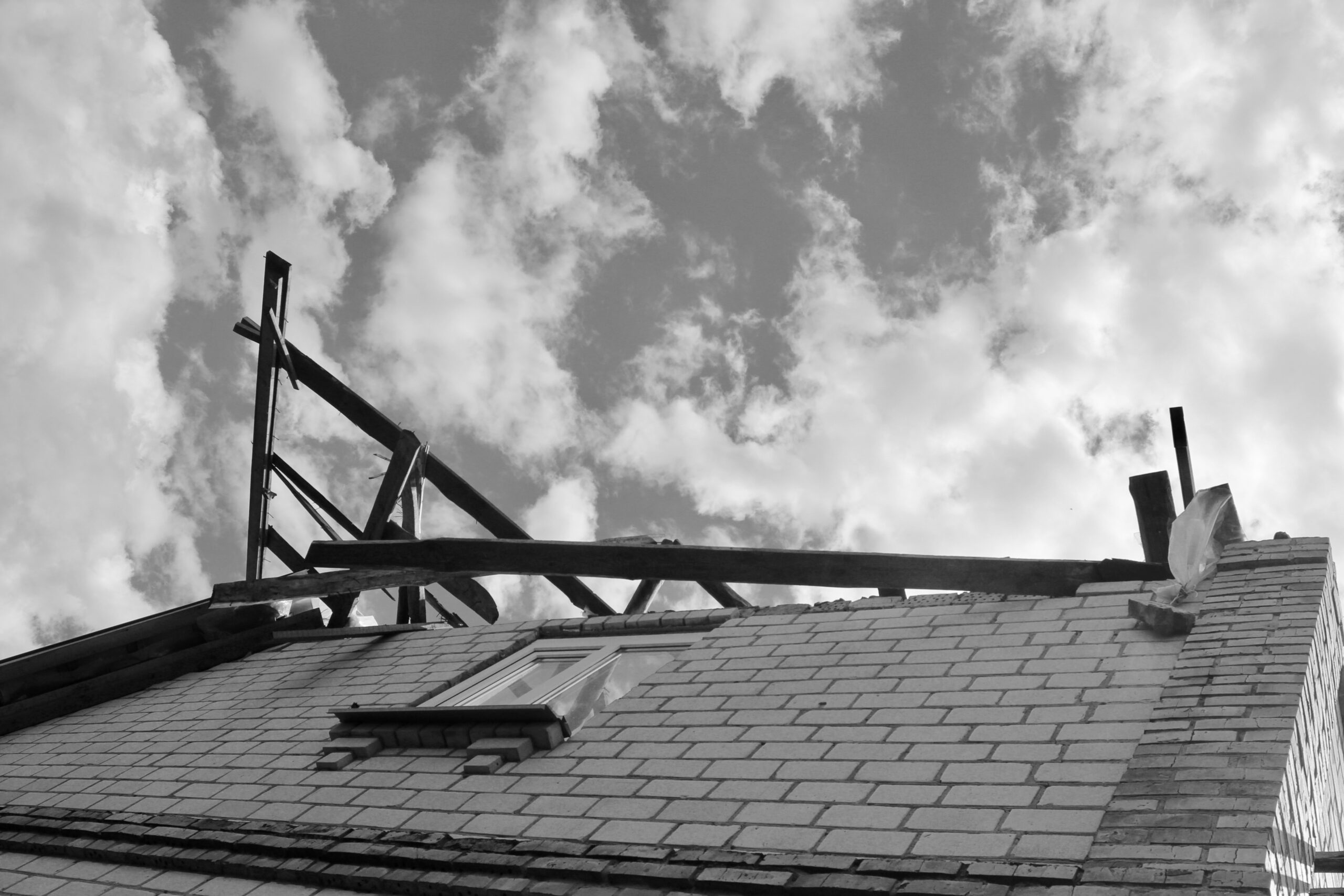Landscape After The Battle — What We Can Learn From Our Ruins?
This text is about the village of Moshchun on the Irpin River, the place near Kyiv where a key breakthrough and containment of the Russian army took place. This text arose from notes I took after visiting the village during April and May 2022. I am grateful to the SONIAKH digest team for the invitation to write an extended version of these notes. The experience of writing was therapeutic for me, and gave me the opportunity to think about the traumatic events that we as a society are going through during Russia's military aggression against Ukraine.
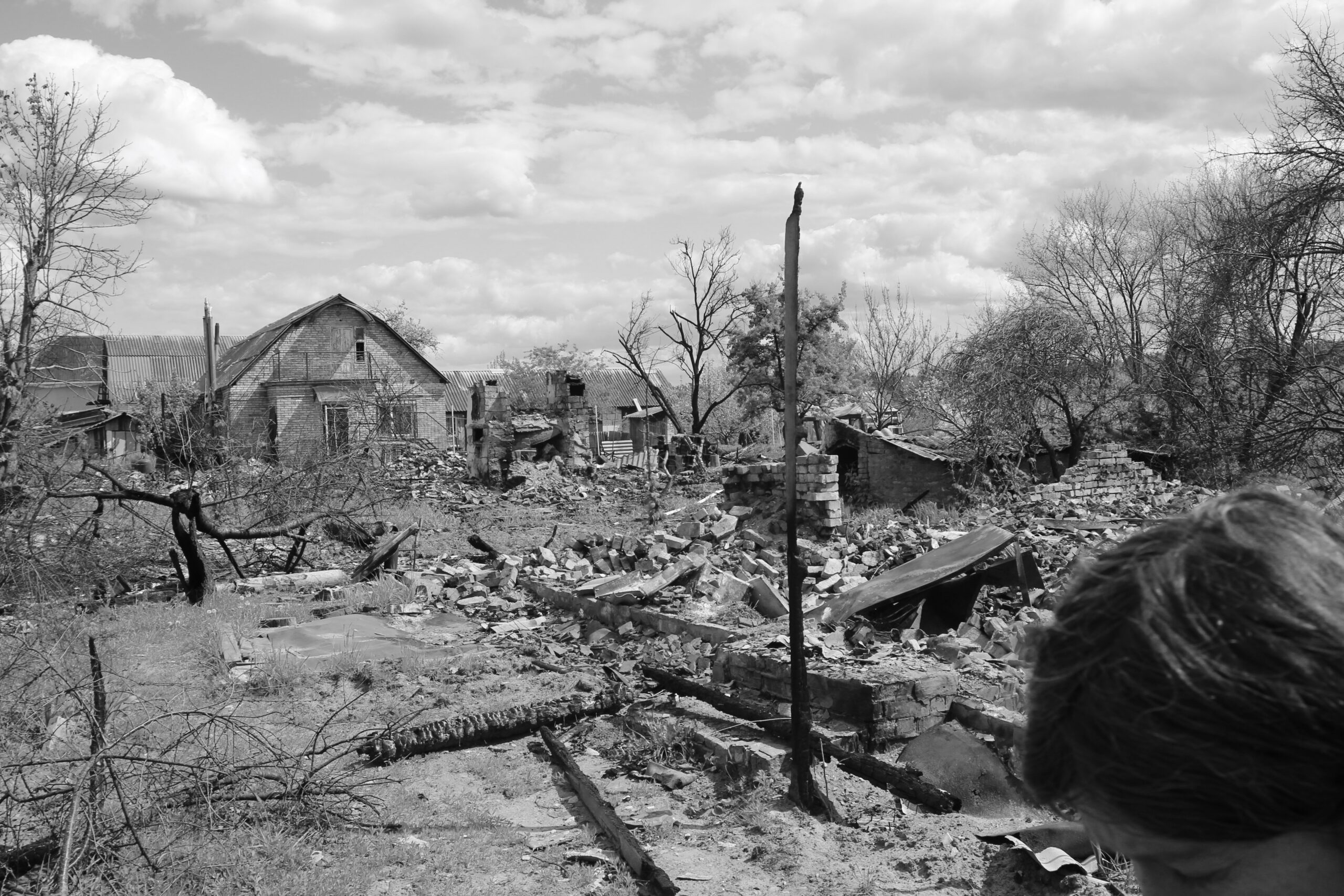
Entering Moshchun, immediately after the forest you pass, there is a checkpoint. During April, there was an ongoing process of demining in the recently de-occupied village, which for several long weeks was at the front line near the Irpin River. Main roads and trails are already relatively safe, but the work of clearing mines continues in private yards and houses. Therefore, at the entrance to the village, you must sign a receipt “I, [surname, name and patronymic, passport number], have been warned about the danger, in the event of my death or mutilation, I have no claim against the Armed Forces of Ukraine.” An effigy of a Russian soldier hangs on a tree next to the checkpoint.
A ruined village greets us on a sunny day, the bloom of spring has just begun. The first greenery is visible, but the gloomy black February-March has not yet retreated. We drive along destroyed Ozerna street, which runs on the side of the road opposite to the forest. In the village, we meet journalists who go in an organized group into private yards accompanied by the army, where they take turns asking local residents about the events.
Moshchun, Horenka, Irpin, Bucha, Hostomel, Borodyanka—this list is not exhaustive. All settlements have turned into temporary museums of the Russian invasion and Russian war crimes. Located near Kyiv, these towns have good transport and infrastructure connections with the capital. At just thirty minutes by car, they are more convenient and safer to visit than the de-occupied territories in Chernihiv oblast, Sumy oblast, Kharkiv oblast, or, even more so, the occupied and completely destroyed settlements of Luhansk oblast, Donetsk oblast, and Kherson oblast. The fighting, which lasted here for the first month of the war, has destroyed almost every house, down to the foundation in some areas. Before the full-scale war, there were almost 800 year-round residents, as well as a significant weekend community. The forest that surrounds the village on all sides has been dug up for the numerous trenches, and the trees are gutted by shelling.
Walking through the village, I try to imagine how many more of such settlements do not make it into the pages of Ukrainian and international media? Being in such a place, you indeed realize the scale of the crimes. I look at the destruction here and think about the eastern Ukrainian cities of my native region: Mariupol, Sieverodonetsk, Rubizhne, Bakhmut, Izyum and others, places that I have visited many times. It hurts me to recall these memories.
///
Reading holes and ruins, I try to imagine what happened here. The Internet is full of testimonies about the events. In March, when I was staying in Kyiv, I saw on news channels an aerial photograph of a devastated village and Russian paratroopers on numerous armored vehicles storming the narrow streets. Now, being physically present here, I observe all those houses without roofs, and the abandoned and broken military equipment in the middle of the streets.
In the fields around the village, you can see many craters from explosions, mine warnings and Russian military uniforms left behind by soldiers who changed into civilian clothes and tried to escape the battlefield.
///
Paradoxically, due to the fact that there are almost no walls and fences left from the destruction, the settlement becomes a more open space for interaction with other people. Residents who have returned to the village are willing to talk and show their destroyed property. They invite others to visit the ruins of their houses. At the stop near the House of Culture, a local community center, we meet a man who turns out to be our neighbor, and he tells us about his evacuation from Moshchun in March. Later we come and visit him in his house. It smells of dampness. Serhii says that the scouts who lived in his house were using the double bed as a toilet and even after a round of cleaning, it is difficult for him to get rid of the smell.
The Armed Forces of Ukraine completely liberated the village on March 21, 2022. The military says that the battle for Moshchun was decisive for the defense of Kyiv. At this crucial time, active hostilities near Kyiv continued day and night.
Units of the 72nd Black Zaporozhian Brigade fought here. Within a short time after the events, a memorial culture formed in Moshchun, and relatives of the fallen defenders of Kyiv gathered there. It was in the village of Moshchun, during the award ceremony commemorating the brigade, that Minister of Defense Serhii Reznikov proposed to change the Soviet honorary title of “Hero City” to “City of Heroes”. Mentioning the actions of the Ukrainian military, the minister also highlighted the role of local residents who had kept the army informed about the slightest movements of the Russians.
In April, the Commander-in-Chief of the Ukrainian Armed Forces, Valery Zaluzhnyi, wrote on Facebook that “the battle for every city and village of our country is worth a separate book” and mentioned the village like this: “Moshchun could have become a gateway for the enemy on their way to the capital. However, our soldiers displayed miracles of military skill. Not only land was burning under the feet of the invaders, but also the water. Ukrainian defenders blew up bridges and pontoon crossings, preventing the enemy from advancing further. They retained Moshchun. Thanks to this, Kyiv was protected.”
The Irpin River can be seen behind the fields of my wife Oleksandra’s family dacha. Upstream in Demydiv, a town where the river flows into the reservoir, the destruction of the dam flooded the plain north of Kyiv and forced the Russian troops to take circuitous route. As a result of this flooding, the area near Moshchun became the front line and prevented the Russians from capturing Kyiv quickly. We are witnessing how the landscape of Kyiv region protected the city by creating a trap into which the entire Kyiv group of the Russian army fell while trying to somehow advance from this direction. The tactic of detonating bridges proved to be very effective for the defenders in the first stages of the invasion.
///
I come to Moshchun in the morning to sort debris. The three-floor dacha, a summer house that was built by my wife’s grandparents, and which is the purpose of our visit, is located on the outskirts of the village, on one of the streets after which the fields and the floodplain of the Irpin River begin. The territory is still mined, but in some places people are already starting to plant vegetables.
Once there, we reconstruct what exactly happened to the house. The village was bombarded with a hail of rockets from the river. One of the shells hit the roof, its fragments scattered and got stuck in the foundation and between the floorboards: some pierced the wooden floor, some got stuck in the walls. Despite this, the house was not irrevocably destroyed, and the impact of the projectile did not start a fire. Most of the neighbors whose houses burned down say that our family was very lucky. Where there was fire, the bricks have become brittle and the walls have to be demolished down to the foundation. In our case, restoration is still possible.
There are large holes in the white brick walls. To the west from the side of the valley, through the cavities in the walls, you can still see a burnt Russian BMD. These are combat landing vehicles. They are a little smaller than other combat equipment, and are designed to be used as support vehicles by Russian paratroopers when storming the area. Large dents most likely indicate 30 mm caliber shots. Such cartridges, with which the house was shot, are usually not used against infantry, but against armored vehicles.
///
We disassemble the debris on the third floor, dismantle the windows and destroyed furniture, and throw them down to be taken away by a truck. It takes a whole day for the group of us to clear the debris. Curfew in the village starts at 8:00 PM, earlier than in Kyiv.
The missile smashed an old bookcase—novels by Dostoevsky, Tolstoy, Fadeev, Ostrovsky spilled out. All of them, published in millions of copies during the Soviet era, lie mixed with dust after the explosion. It is difficult to breathe here because of fiberglass particles in the air. I carefully gather these books and put them in boxes, wiping the dust from them. Apparently, this is how hegemony collapses. Years ago already, these books were no longer needed by anyone in our family, and they were all packed off to the country house. Now, out of despair at the impossibility of offering a critical view of these books and their cultural heritage, the Russians, complete the the loss of their position of power by coming here and literally turning their patrimony in Ukraine into construction debris with a well-aimed rocket.
///
A little later, I dig out a fifth grade textbook on Russian language—my native language, which I use less and less these days. I pick up Alexei Tolstoy’s book, Pyotr the First. It has the following quote on the back cover: “I was looking for clues to the Russian people and Russian statehood in this topic.” How valuable these ruins are!
Nikolai Ostrovsky. How the Steel Was Tempered. We had this book at home in Luhansk. I remember reading it in eighth grade sitting in the garden under the cherry trees. A Hero of Our Time, The Captain’s Daughter, The Minor. The plots of these novels become syncretic. Protect the honor of youth by organizing an occupation. The epilogue of Russian romance is to be covered with rubble. Walter Benjamin has a text called Unpacking My Library: A Talk about Book Collecting. He asks the reader to smell the paper and get excited about the collecting process. I understand this smell well, I often breathe it together with my wife. But what does it mean to collect books with our eastern side next to Russia? Doesn’t this smell mix in some places with the smell of ashes, soil and fiberglass?
Blok, Borges, Bradbury, Brodsky, Hasek, Hugo, Deresh, Joyce, Dostoevsky, Exupery, Zhadan, Zamyatin, Zoshchenko, Kafka, Kerouac, Cortazar, Kuprin, Mandelstam, Mayakovsky, Milosh, Orwell, Ostrovsky, Pasternak, Platonov, Prokhasko, Tolstoy, Turgenev, Wald, Faulkner, Huxley, Hemingway, Chekhov, Yesenin—my family’s library has become covered with mold in my childhood house in Luhansk, after my parents left their occupied city.
These vestiges of past imperial control and power became more visible than ever this spring. Dust-covered books of Russian writers can be found all over Ukraine, just as their names can be found among the names of streets and settlements, some of which have recently seen battles with the Russian army. Street names were a tool to erase local memory. Alexander Etkind, a postcolonial researcher from Russia, once wrote in his book Internal Colonization: “the empire collapsed, but literature survived it.”[1] Being here in the Kyiv urban agglomeration next to Bucha and Irpin, I contemplate how, in the literal sense, literature has now collapsed from its shelf after the empire.
///
According to the Kyiv Regional Military Administration, 2,000 buildings were destroyed and damaged in Moshchun during the war. These are almost all the buildings of the village. In particular, 921 private houses, the same number of commercial buildings and structures. 20 industrial buildings were destroyed and damaged. 18 greenhouses, 3 shops, 2 hotels, a school, a church, a cemetery, a cultural center and a post office. Due to the rapid de-occupation in April, the infrastructural damage of Moshchun was quickly calculated after the liberation by the Cabinet of Ministers of Ukraine. It amounted to 1,100,000,000 hryvnias (approximately $30 million dollars).[2]
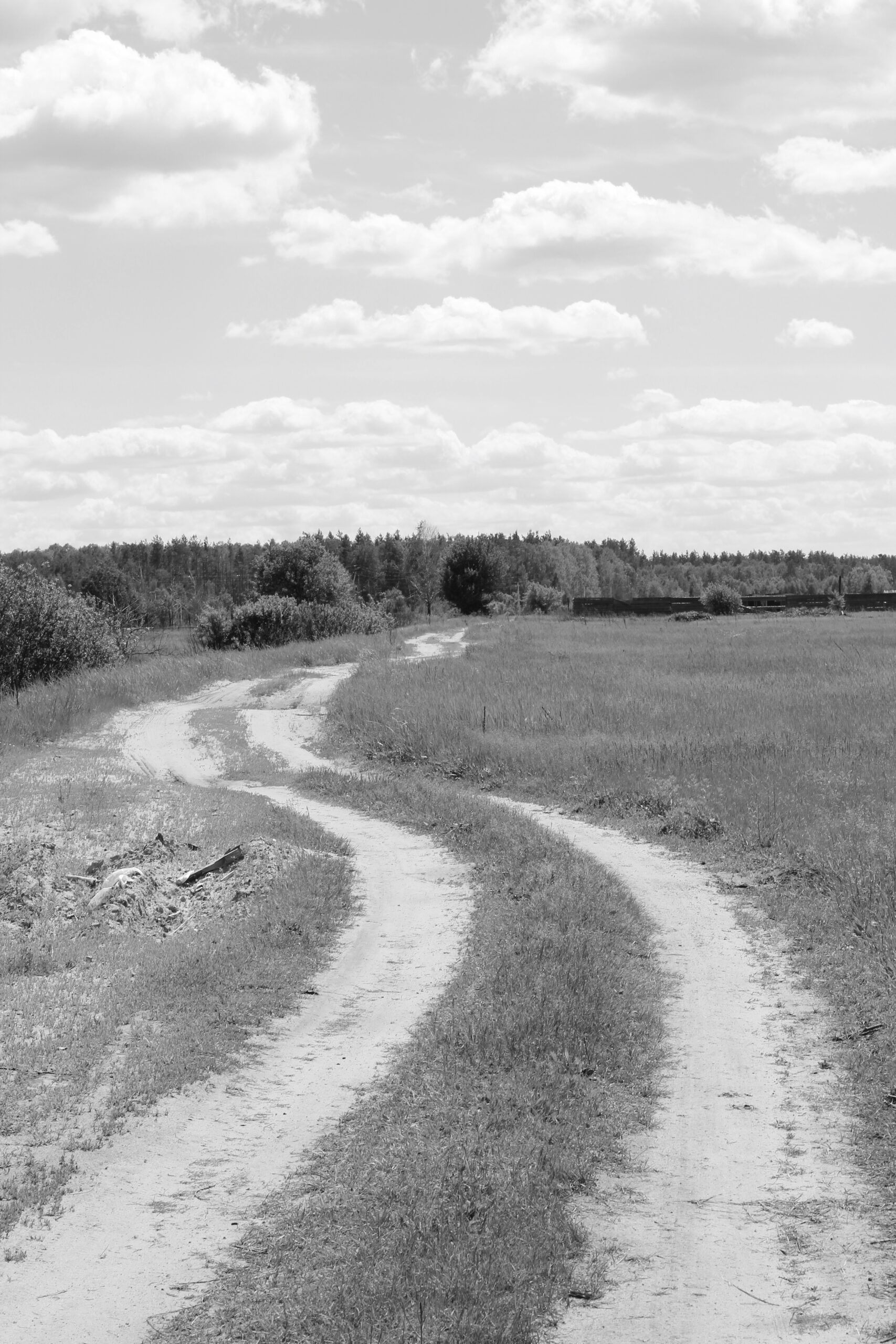
///
Like most Ukrainian citizens from eastern Ukraine, I feel deja vu. This has already happened in Donetsk and Luhansk. Russian imperialism has been consistently destroying Ukrainian culture since the beginning of this war in 2014: Russians ban Ukrainian education, language and history in the occupied territories. They change names, destroy heritage, and kill and torture Ukrainian citizens.
Should the radical opinion of war-affected people become a new moral imperative of Ukrainian society? All the public discussions to which we are now accustomed take place against the backdrop of this devastated post-battle landscape.
///
At the beginning of May 2022, when the final occupation of the city of Mariupol was still incomplete, the Russian occupiers had already replaced the bilingual road signs “Маріуполь/Mariupol” with the monolingual and written in Russian “Мариуполь”. The Russians did not need to hold public discussions for this—it was enough to seize the city by force. There is no end to this aggressive speed and radicalism imposed on us by Russia since February 2022. Can we imagine the end of war?
///
What do the ruins of our houses teach us? I tend to think of this story as a notorious plot about crime without punishment. It is this story that I am excavating in the ruins of Moshchun, together with this dusty copy of Fyodor Dostoyevsky. This is precisely what the Ukrainian generals see as the center of gravity and the potential end of this war, when they do not have the opportunity to symmetrically respond 2,000 km deep into the country of the aggressor.[3] The very possibility of starting the war was predicated on this principle of impunity—Russia began shelling Kyiv and other Ukrainian cities, knowing that this would not be followed by an attack on Moscow. Russia, in order to learn something, must lose this war. Criminals must suffer their punishments.
I thank all my attentive readers for reading these notes to the end. I am happy for you that you have the opportunity to learn from someone else’s experience. Let’s consolidate these lessons together—UKRAINE NEEDS MORE WEAPONS TO FULLY REGAIN ITS TERRITORIES!
- Alexander Etkind, Internal Colonization: Russia’s Imperial Experience, Polity, 2011
- As in Moshchun, it is common for the war damage to infrastructure in a single village in the Kyiv region to amount to over a billion hryvnias (more than $27 million dollars). https://kse.ua/ua/about-the-school/news/zbitki-infrastrukturi-lishe-odnogo-sela-na-kiyivshhini-vid- viyni-stanovlyat-mayzhe-1-1-mlrd-griven/
- Prospects for running a military campaign in 2023: Ukraine’s perspective: https://www.ukrinform.net/rubric-ato/3566404-prospects-for-running-a-military-campaign-in-2023-ukraines-perspective.html
Dmytro Chepurnyi is curator and writer based in Kyiv, and an affiliated curator at Asortymentna Kimnata in Ivano-Frankivsk. He was born in 1994 in Luhansk, north of the Donetsk coal basin. He graduated from Cultural Studies department at Taras Shevchenko National University of Kyiv. From 2016 to 2020, he collaborated with IZOLYATSIA Foundation and coordinated Donbas Studies research project. He has been a Visiting Fellow at the University of St Andrews (UK) and a member of the group Donbas Through Collaborative Frameworks (Ukraine/UK). He is a co-author of the book Limits of Collaboration: Art, Ethics, and Donbas (2022) together with Victoria Donovan and Daria Tsymbalyuk, and a сo-author of the publication Curatorial Handbook (2020) together with Oleksandra Pogrebnyak and Kateryna Iakovlenko. He has curated various art residency programs, in particular, Landscape As a Monument (2020), Contemporary Art Rivne (2021), and When Was the Story Interrupted? (2022).
Published 13 December 2022

